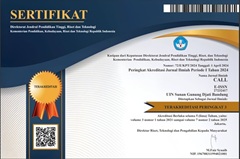FLOUTING MAXIM OF QUANTITY IN THE CHARACTERS’ DIALOGUES IN “DETECTIVE PIKACHU†MOVIE
DOI:
https://doi.org/10.15575/call.v3i1.12838Abstract
Detective Pikachu movie, a family genre movie, has universal cultural identity across countries even continents which is representative of internationally accepted movies through all ages and culture. Communication between speakers and listeners should fulfill maxims in order to have an effective communication and to avoid misunderstanding. The research uses Grice's theory of the Cooperative Principle in order to describe the communication that happens among the characters in the movie. The purpose of this research is: to find out maxim of quantity flouted in the characters’ dialogue in Detective Pikachu movie and to find out the other characters involved in the dialogue respond to this flouting maxim of quantity. The obtained data were analyzed with descriptive qualitative method. As the findings, there are 30 data flouting maxims of quantity has flouted in the characters dialogue in Detective Pikachu movie. Almost all of the characters in the movie flouted the maxim of quantity. The characters are said to be flouting the maxim of quantity because they are in the dialogue that occurs. They are too much or too little in providing information. When viewed from the comparison of the dialogue in the movie, giving too much information is more often done by the characters than giving too little information. the other hearer responds to the speaker who flouted the maxim of quantity is not to be bothered by this because it is helped by the implicature, insights and experiences of the characters so that the dialogue can still work well.
Â
Keywords: Pragmatics; Cooperative Principle; Flouting MaximÂ
References
_Brown, Y. (1983). Discourse Analysis. Cambridge: Cambridge University.
_Creswell, J. W. (2014). Research Design. London: SAGE.
_Cutting, J. (2008). Pragmatics and Discourse. London: Routledge.
_Djadasudarman, F. (2012). Wacana dan Pragmatik. Bandung: Refika Aditama.
_Djajasudarma, D. T. (1993). Metode Linguistik: Ancangan Metode Penelitian dan Kajian. Bandung: Eresco.
_Edi. (2012, Maret 01). Aspek-aspek pragmatic: Tindak tutur, Praanggapan, Implikatur. Retrieved from Wordpress: https://edisuryadimaranaicindo.wordpress.com/2012/03/01/aspek-aspek-pragmatik-tindak-tutur-praanggapan-dan-implikatur-2
_Grice, H. (1989). Studies in the Way of Words. Cambridge: Harvard University Press.
_Grice, H. P. (1989). Studies in the Way of Words. Cambridge: Harvard University Press.
_Levinson, S. C. (1983). Pragmatics. New York: Cambridge University.
_Moleong, L. (2014). Metodologi Penelitian Kuantitatif. Bandung: PT REMAJA ROSDAKARYA.
_Parker, F. (1986). Linguistics for Non Linguists. London: Taylor and Francis.
_Thomas, J. (1995). Meaning in Interaction to Pragmatics. New York: Routlegde.
_Thompson, B. D. (1997). Film Art: an Introduction. New York: McGraw-Hill.
_Yule, G. (1996). Pragmatic. New York: Oxford University Press.
Downloads
Published
Issue
Section
Citation Check
License
Authors who publish in CALL agree to the following terms:
- Authors retain copyright and grant the journal right of first publication with the work simultaneously licensed under Attribution-ShareAlike 4.0 International (CC BY-SA 4.0) License that allows others to share the work with an acknowledgment of the work's authorship and initial publication in this journal.
- Authors are able to enter into separate, additional contractual arrangements for the non-exclusive distribution of the journal's published version of the work (e.g., post it to an institutional repository or publish it in a book), with an acknowledgment of its initial publication in this journal.
- Authors are permitted and encouraged to post their work online (e.g., in institutional repositories or on their website) prior to and during the submission process, as it can lead to productive exchanges, as well as earlier and greater citation of published work (See The Effect of Open Access).




